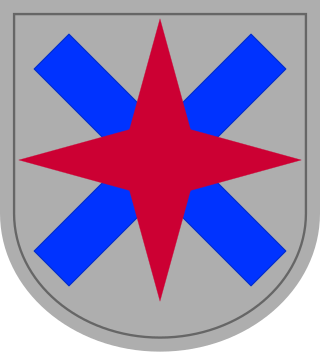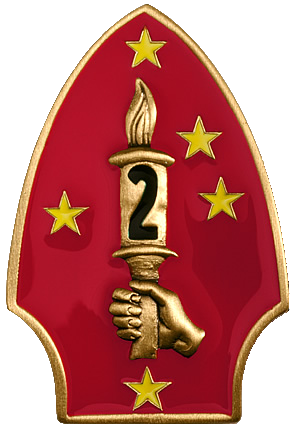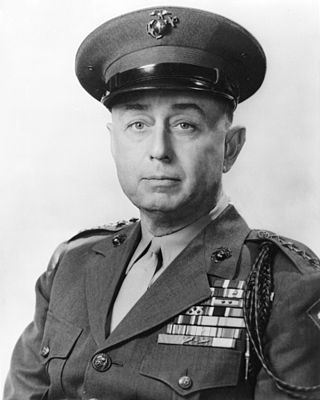
The Battle of Iwo Jima was a major battle in which the United States Marine Corps (USMC) and United States Navy (USN) landed on and eventually captured the island of Iwo Jima from the Imperial Japanese Army (IJA) during World War II. The American invasion, designated Operation Detachment, had the purpose of capturing the island with its two airfields: South Field and Central Field.

The Americal Division was an infantry division of the United States Army during World War II and the Vietnam War.

XIV Corps was a corps-sized formation of the United States Army, originally constituted on 1 October 1933 in the Organized Reserves. The history of XIV Corps in World War II dates from December 1942. Then, under Major General Alexander Patch, the XIV Army Corps directed the American 23rd Infantry Division and 25th Infantry Divisions, the 2nd Marine Division, and the 147th Infantry Regimental Combat Team in the final drive that expelled the Japanese from Guadalcanal early in February 1943. The 70th Coast Artillery Regiment (Anti-Aircraft) landed on 23 May 1943. From air fields guarded by the XIV Army Corps, Allied aircraft began the neutralization of the enemy's vital Munda airfields on New Georgia.

This is the order of battle for the Guadalcanal Campaign, called Operation Watchtower, the first major Allied offensive in the Pacific Theater of Operations in World War II. The campaign lasted from the initial American landings on 7 August 1942 until the final Japanese evacuation on 9 February 1943, a period of six months, far longer than was expected by Allied planners.

The 37th Infantry Division was a unit of the United States Army in World War I and World War II. It was a National Guard division from Ohio, nicknamed the "Buckeye Division". Today, its lineage is continued through the 37th Infantry Brigade Combat Team, with battalions from Ohio, Michigan, and South Carolina.

Operation Downfall was the proposed Allied plan for the invasion of the Japanese home islands near the end of World War II.

Sergeant Darrell Samuel Cole was a United States Marine who posthumously received the United States' highest military decoration, the Medal of Honor, for his conspicuous gallantry at the Battle of Iwo Jima during World War II.

The 2nd Marine Division is a division of the United States Marine Corps, which forms the ground combat element of the II Marine Expeditionary Force. The division is based at Marine Corps Base Camp Lejeune, North Carolina and headquartered at Julian C. Smith Hall.

Clifton Bledsoe Cates served as the 19th Commandant of the Marine Corps from 1948 to 1951, holding the rank of a United States Marine Corps four-star general. He earned recognition for his heroism during World War I at the Battle of Belleau Wood and for his exceptional leadership during the Battle of Iwo Jima in World War II. Cates is widely regarded as one of the most distinguished young officers of World War I. His remarkable career included commanding a platoon, a company, a battalion, a regiment, and a division, making him one of the few officers across all branches of service to have achieved this feat in combat.
1st Battalion, 8th Marines (1/8) is an infantry battalion in the United States Marine Corps based out of Marine Corps Base Camp Lejeune, North Carolina. The battalion consists of approximately 1000 Marines and sailors and is nicknamed "The Beirut Battalion." The battalion falls under the command of the 6th Marine Regiment and the 2nd Marine Division.

The 6th Marine Regiment is an infantry regiment of the United States Marine Corps based at Marine Corps Base Camp Lejeune, North Carolina. The regiment falls under the command of the 2nd Marine Division of the II Marine Expeditionary Force. Its combat history dates back to World War I when they were part of the American Expeditionary Force. They fought in the Pacific Theater in World War II, most notably at the battles of Guadalcanal, Tarawa, Saipan, Tinian and Okinawa. More recently, the regiment has seen combat during the Gulf War and in support of Operation Iraqi Freedom.

The 23rd Marine Regiment is a reserve infantry regiment of the United States Marine Corps. It is headquartered in San Bruno, California and falls under the command of the 4th Marine Division and the Marine Forces Reserve.

On 15 June 1944, United States Marine forces landed on the southwest coast of the island of Saipan in the central Marianas chain; these were followed a day later by US Army forces. This invasion was part of Operation Forager, an effort to recapture the entire Marianas chain from the Empire of Japan.

1st Battalion, 23rd Marines (1/23) is one of 32 infantry battalions in the United States Marine Corps, and one of only eight battalions found in the reserve. It is located throughout Texas and Louisiana consisting of approximately 1000 Marines and Sailors. They fall under the command of the 23rd Marine Regiment and the 4th Marine Division.

The Battle of Mount Austen, the Galloping Horse, and the Sea Horse, part of which is sometimes called the Battle of the Gifu, took place from 15 December 1942 to 23 January 1943 and was primarily an engagement between United States and Imperial Japanese forces in the hills near the Matanikau River area on Guadalcanal during the Guadalcanal campaign. The U.S. forces were under the overall command of Major General Alexander Patch and the Japanese forces were under the overall command of Lieutenant General Harukichi Hyakutake.

The 182nd Infantry Regiment is a regiment of the United States Army, forming part of the Massachusetts National Guard. It is among the oldest regiments in the U.S. Army, tracing its organizational roots back to 1636, and is one of several National Guard units with colonial roots and a campaign credit for the War of 1812.

The 145th Armored Regiment, Ohio Army National Guard, is a parent regiment under the U.S. Army Regimental System, with headquarters at Stow, Ohio. It currently consists of the 1st Battalion, 145th Armored Regiment, a 600-soldier combined arms battalion of the Ohio Army National Guard located throughout northeast Ohio.
The 161st Infantry Regiment is a ceremonial infantry regiment of the United States Army and the Washington Army National Guard. It is the oldest unit in the Washington Army National Guard tracing its lineage to the separate Infantry Companies of the Territorial Militia. Its 1st Battalion is a stryker-based element of the 81st Stryker Brigade Combat Team consisting of three stryker infantry companies and one headquarters company, with its headquarters in Spokane, Washington.

The 146th Infantry Regiment was an infantry regiment of the United States Army, Ohio National Guard. It was formed in 1917 from the old 8th Ohio Infantry Regiment and served in several American wars from 1898 to 1919.

A joint assault signal company (JASCO) was a joint service unit that provided ship to shore and air to ground communications to coordinate and control naval gunfire and close air support for American land forces during World War II. They were composed of specially trained officers and enlisted personnel from the Navy, Marines, and Army. The Army component was composed of Air Liaison Officers and enlisted communications technicians. JASCOs were created in the Pacific because previous small communication teams were ineffective and only served to clutter communications. After the costly Battle of Tarawa, the need for centralized command and control of air and naval fire support between the Navy, Marines, and Army was seen. Major General Alexander Vandegrift formed the Joint Assault Signal Companies based on his experiences in the Guadalcanal campaign. Navajo and other Native American code talkers were often attached to JASCOs.



















